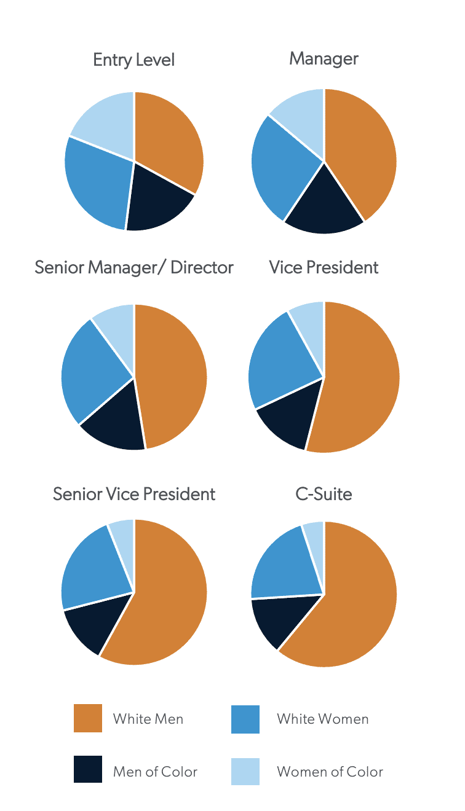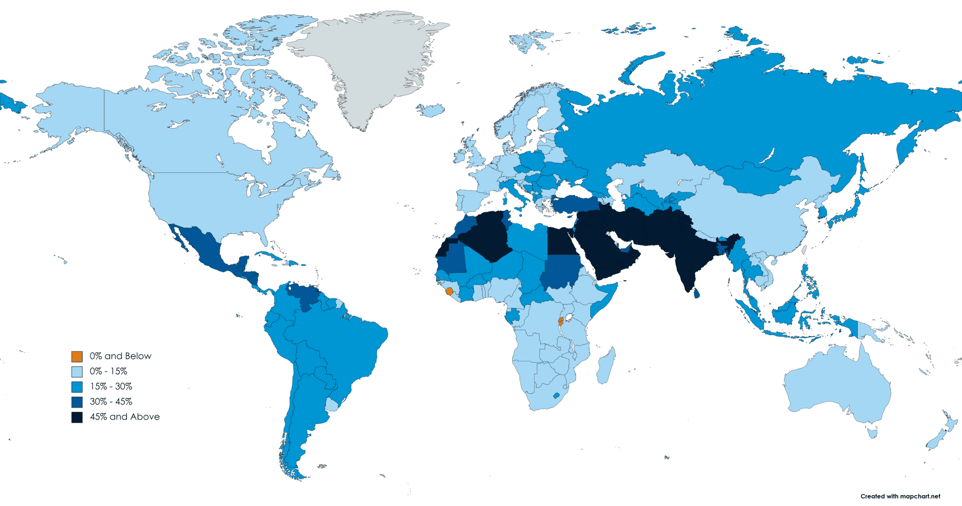Supporting Women in the Workforce
As the labor market grows increasingly competitive, organizations must continue to bridge the gender gaps that exist globally, focusing their recruiting efforts on women and working mothers. Women and moms in the workplace face multiple biases that can encourage them to leave the workforce, but appropriately promoting women at higher pay rates, expanding parental benefits to include paid leave, childcare, and upskilling and reskilling opportunities can help retain women and working mothers.
Equally important is creating a company culture of inclusivity, where women are recognized for their skills and compensated accordingly, and moms are not penalized for taking advantage of the benefits provided by the government or their employer. Ultimately, women and moms bring valuable skills to the table, and employers who engage with these talent pools will be more successful in the long run.
The “Broken Rung” and Its Historical Impacts on Women in the Workforce
Between the 1970s and 1980s, women made large strides towards accessing positions of power and authority within the workplace. By the 1990s, however, progression slowed considerably and continues to stall today. According to the McKinsey & Company Women in the Workplace 2022 report, despite modest gains in representation over the last eight years, only 1 in 4 C-suite leaders is a woman and only 1 in 20 is a woman of color.
Women are still faced with the “broken rung” phenomenon holding them back from getting promoted to managerial positions at much lower rates than men. The McKinsey report notes that for every 100 men who are promoted from entry-level roles to manager positions, only 87 women are promoted and only 82 women of color are promoted. Because of this, women cannot catch up and men significantly outnumber women at the managerial level. As the “broken rung” continues, we have also seen that women leaders have been leaving their companies at the highest rate than ever before. For every woman who gets promoted at the director level, two women directors are choosing to leave their employers, according to McKinsey.
Organizations with greater diversity among leadership roles are 2.4 times more likely to outperform their competitors. McKinsey’s Delivering Through Diversity report found that corporations pursuing gender diversity among the executive teams were 21% more likely to experience above-average profitability. Unfortunately, the pandemic had a significant impact on women. Many opted out of the labor force during 2020, with a large portion doing so due to lack of childcare support. Despite women beginning to re-enter the workforce in efforts to support family costs amid higher inflation rates, the women’s labor force participation growth rate is forecasted to slow further into 2024.
The Fortune 500 crossed a milestone for the first time in history at the beginning of 2023, with more than 10% of the businesses on the list having a woman run the company. However, 72% of women leaders under the age of 35 have reported a heightened feeling of burnout, according to global leadership consulting firm DDI.

Representation of Men and Women by Corporate Role and Race 2022
(% of Employees)
Source: McKinsey & Company
The Gender Gap Hits College Campuses
These days, there are roughly three women students for every two men on college campuses, according to the nonprofit National Student Clearinghouse. Women became a majority of college students in 1979, with the trend line continuing to rise to today. The latest data suggests that the pandemic led more men than women to opt out of college. These trends are not unique to the US, as among 25- to 34-year-olds, women are more likely to have a tertiary degree than men in all 38 countries that are members of the Organization of Economic Cooperation and Development (OECD).
Yet, despite the rise in women’s education, women continue to see their pay lag behind that of men. In 2022, women earned 17% less than men on average, with women continuing to earn only 82 cents for every dollar a man makes, according to Forbes Advisor. Additionally, we continue to see men still make up the majority of students in some of the highest-paying fields, such as business, computer science and engineering.
Labor Force Participation Shows Continued Gender Gap
According to the International Labor Organization (ILO), the global labor force participation rate for women is just under 47%, whereas men sit at 72%. Almost all countries continue to see a lower participation rate in women in the workforce than men, with some regions reporting a gender gap higher than 50 percentage points. Some of the countries with the lowest gender gap include the US (11.2%), Canada (8.9%), the UK (9.1%), Sweden (6.3%), Germany (9.2%) and Australia (9.4%). Countries in the Middle East and India continue to have some of the largest gaps. In India, the participation rate for women in the workforce sits at only 19.2%, indicating a gap of 50.9 percentage points. Much of the cause for this gender gap in labor force participation stems from cultural norms surrounding women in the country.
Though women have been working to bridge the gap, we continue to see persistent challenges facing women in the workforce today. A survey from the Harvard Business Review found 73% of men and 85% of women used the work/family narrative as reason why women continue to have stalled advancements in the workplace. This narrative stems from the idea that women cannot invest the time needed for high-level jobs due to their devotion to family and as a result their careers suffer.
Additionally, women still shoulder the majority of invisible and undervalued household workloads, creating struggles for many between paid work and family responsibilities. Globally, there is a lack of affordable care for children or family members, which further creates obstacles for both women looking for a job and those already in paid work. The ILO reported that this, in fact, decreases a women’s participation chances by almost 5% in developing countries and 4% in developed countries.

Gender Gap in Labor Force Participation Rates
Source: ILO
Many Women in the Workforce Juggling Motherhood
Despite the gender gap in workforce participation across the globe, mothers make up a critical share of the workforce. In the US, 71.2% of moms participated in the workforce in 2021. However, most of the world views women as the primary parent, meaning they are primarily responsible for caring for children. The pandemic highlighted this phenomenon, when more than 2 million mothers globally left the workforce to care for children as school was moved to remote, according to the World Economic Forum. Because women are viewed as the primary caregiver, they typically take more leave than men, and are more likely to exit the workforce to care for children, leading to unequal labor market outcomes for men and women. As the labor market grows increasingly competitive, companies can no longer ignore mothers as a talent pool, and must offer parental benefits to retain this group of talent.
While working mothers are penalized for having a child, working mothers add value to their organizations through the skills they bring to the table. A study conducted by WerkLabs, in collaboration with The Mom Project, found that mom managers are rated 18% more favorably than other managers, while female employees with colleagues or managers who are moms were more like to stay with their current employer relative to those without colleagues or managers who are moms. Working mothers offer valuable skill sets to their organizations, and efforts to retain this demographic are increasingly important in a tight labor market.
The State of Maternity Leave Globally
The OECD defines maternity leave as the “employment protected leave of absence for employed women directly around the time of childbirth.” The length of maternity leave varies considerably by country, but most countries offer income support during a portion of the leave, according to the OECD. The average length of paid maternity leave globally is 29 weeks, while the average length of paid paternity leave is 16 weeks, a New York Times article reports. While virtually all wealthy nations have legislation for paid maternity leave, many middle- and low-income countries also make provisions for paid leave. For example, India passed legislation in 2017 that allots for 26 weeks of paid leave, along with other stipulations related to flexible work arrangements and childcare.
In the US, there is no right to paid maternity leave, making the US one of six countries that doesn’t have any federally protected right to paid leave. Eligible employees in the US can take up to 12 weeks of protected, unpaid maternity leave under the Family and Medical Leave Act, according to an article in Time. However, Center for American Progress (CAP) reports that many states have since passed supplemental leave laws, with 11 states and Washington DC passing laws that offer some income supplement during maternity leave.
In addition to state regulations, many employers now offer maternity benefits. For example, Thomas Reuters offers employees a minimum of 16 weeks of paid leave globally, while Spotify and Etsy offer 26 weeks of paid leave to new parents. While employer-provided benefits certainly aid an organization’s workforce, the majority of the workforce doesn’t have access to paid leave, with lower-income workers being less likely to have access to paid leave. In fact, only 24% of workers in the US had access to paid leave, but in industries such as leisure and hospitality, accommodation and food service, and transportation and warehousing, 10% or less of workers had access to paid leave, according to CAP. Without access to paid leave, many working mothers are unable to take leave at all – 1 in 4 women in the US return to work 10 days after giving birth, reports the World Economic Forum. In an increasingly competitive labor market, offering paid leave to new mothers can help attract and retain working mothers.
- The US offers no paid family leave, though roughly half of private sector employees qualify for 12 weeks of unpaid leave.
- In Canada, the pregnant person can take up to 15 weeks of maternity leave. There is an additional 40 weeks of parental leave that can be shared between both parents, during which a partial portion of the wage is paid.
- In the UK, eligible employees can take up to 52 weeks of maternity leave, and eligible employees can receive a portion of their income for up to 39 weeks.
- In Germany, the pregnant person is entitled to six weeks of paid leave before the expected birth week and eight weeks after. Additionally, one parent can take up to a year off with 60% of their pay, while the other can take two months off.
- Mothers in France receive at least 16 weeks of paid leave, though this number increases if the mother already has children or is expecting more than one child. After the 16 weeks, a parent can take up to a year of leave, and depending on income, may be eligible for social assistance.
- In India, mothers are entitled to 26 weeks of paid leave. The employer is required to pay full wages, and following the 26 weeks, they might be required to provide a work-from-home option and/or nursery facility depending on the number of employees.
- Australian mothers can take up to 12 months of maternity leave, 18 weeks of which are paid. Depending on an individual’s circumstances, a mother could be entitled to an additional year of maternity leave.
Is the "Mom Penalty" a Reality?
Childbirth is one of the most significant events in a woman’s life, yet in the professional world, working mothers are still subjected to unfounded biases that negatively impact their professional lives. These biases, known as the “motherhood penalty,” impact women in multiple ways:
- Compensation: In most countries, there’s a pay gap between men and women, but the gap widens for mothers, so much so that the World Economic Forum predicts that 80% of the pay gap between men and women is due to the “mom penalty.” In the US, working mothers earn 69 cents for every dollar a man makes. The UK demonstrates a similar phenomenon – women earn 18% less on average than men, while mothers earn 33% less on average 12 years after the birth of the first child, an article in The Guardian
- Perceived Competence: Compared to childless women, working mothers are perceived as less competent, which in turn leads to hiring bias and more limited leadership opportunities. Studies demonstrate that mothers receive fewer call backs than childfree women, and after the birth of a first child, a mother’s chance of being a manager declined, according to The Globe and Mail. In India, where traditional gender roles have a strong hold, 27% of mothers advance in their careers following the birth of their child, while only 16% advance to senior leadership positions.
- Maternity Leave: In most countries, qualifying working mothers have a federally protected right to some period of maternity leave, either paid or unpaid. Additionally, employers often provide moms with additional maternity-related benefits. However, women are often penalized for using these benefits. For example, in California, where mothers are allotted a period of paid leave following the birth of a child, a study conducted by UCLA economist Martha Bailey indicated that women who took leave had on average 7% lower employment and 8% lower annual earnings relative to mean.
Beyond Maternity Leave: Retaining Working Moms
Mothers are a critical part of the talent pipeline, and attraction and retention of this demographic goes beyond paid maternity leave. Working moms continue to face barriers in the workplace, and organizations can offer support to mothers through various means, including offering supplemental childcare, being flexible on work arrangements and doing phased returns, and offering returnship programs to help mothers re-enter the labor force.
- Childcare: This is one of the main barriers working women face. Childcare costs are prohibitive, and there are fewer childcare workers now than before the pandemic, exacerbating the issue, according to HR Dive. As a result, there tends to be an employment gap between men and women, illustrated by the number of women who left the workforce in the wake of the pandemic in response to school shutdowns. Subsidizing childcare helps to decrease the employment gap and allows women to return to the workforce. For example, in Quebec, which has a universal low-fee childcare program, the gender employment gap is smaller than in other provinces in Canada, The Globe and Mail reports. In the US, some companies have begun offering subsidized, back-up childcare, according to LinkedIn.
- Flexible Work Arrangements: Related to childcare, offering flexible work arrangements can be useful in attracting working mothers. Hybrid and remote options are typically the first thing we associate with flexible work arrangements but offering roles that are traditionally full-time on a part-time basis can also help employers successfully recruit working mothers. For example, Zurich Insurance began advertising roles as both full-time and part-time, and found that women are more likely to apply for the roles.
- Focus on Fathers: Women are still considered the primary parent in the vast majority of the world. Consequentially, mothers take more leave than fathers, which can lead to unequal labor market outcomes between men and women. However, placing more emphasis on fathers when discussing parental benefits can help close this gap. Men are often discouraged from taking paternity leave by their employers, but encouraging fathers to take leave can help assuage some of the unconscious bias towards working mothers, according to an article in Time.
- Returning to Office: Many women report not feeling supported during their maternity leave and their transition back to work, with many mothers considering quitting during the return-to-work process, The Globe and Mail reports. Ensuring a smooth, supportive return to work is essential to retention. Additionally, some firms have shifted to a phased return to work, where mothers returning from maternity leave will return on a part-time basis at first but receive full-time benefits, according to LinkedIn. This allows new mothers to ease back into the workforce while balancing professional and familial responsibilities. However, an article from Forbes cautions that offering these benefits alone are not enough; women must not be penalized for using them. For women who have been out of the workforce for an extended period of time, “returnships” present opportunities to reskill or upskill as well as re-enter the workforce gradually. Returnships have grown in popularity in India, and they help women learn new skills and settle into the workplace, with the potential of a full-time job at the end of the program, according to the Economic Times of India.
When it comes to women in the workforce, leaders should prioritize wellbeing, flexibility and family support – benefits many women are seeking either to stay with their current employer or to re-enter the workforce. Ultimately, making strides to close gender gaps – whether it be in the labor force as whole, on college campuses, in leadership capacities or relative to maternity leave and working moms – would not only benefit women and their households, but the entire global economy.
-min.png)






